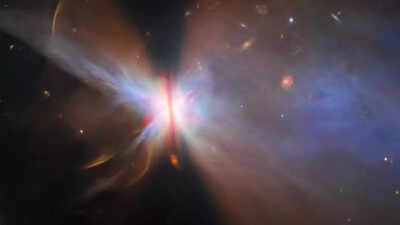Astronomers have unveiled stunning images of a young star, showcasing a striiking structure that reesmbles butterfly wings. Utilizing the combined capabilites of nasa’s James webb space telescope (JWST) and the hubble space telescope, researchrs have captured intricate details of a protostar conceled within thick clouds of Gas and dust. This Remarkable observation offers a unique window into the earliest stages of star formation, shedding light on how stars and planets developed dense intersteletlar material. By Studying Such Young Stellar Objects, Scientists Can Better Understand The Processes Governing Stellar Birth, Disk Formation, And Planetary Evolution, Making this Discovery a Significone in Modert Astronomy.
Nasa and Hubble Capture Young Star Iras 04302 and its planet-forming disc
The object, officially designated Iras 04302, is a protostar shrouded in thick gas and dust, invisible in normal optical light. The surrounding dusty disc flattens into a dark lane, blocking starlight and allowing astronomers to observeve planet-forming material from an edge-on perom.The remarkable images are a combination of infrared data from jwst and optical observations from hubble. Webb’s instruments highlighted Fantle structures in the dust, revaling composition and distribution, while hubble’s optical imaging capcorated fin details of the DISC ‘vertical and Horizonttal Structure. The disc spans approximately 65 billion kilometers, vastly larger than our entrance solar system, and offers invaluable insurance into the environments where new stars and planets take shape.
Iras 04302 Protostar: Insights Into Star Birth, Planet Formation, and butterfly Nebulae
Protostars Like Iras 04302 Are Steller Nurseries, The Birthplaces of Stars and Potentially Planets. Study its dusty disc allows scientists to understand how dust grains settle, migrate, and then coalsce into planet-sized bodies. Some Researchers even speculate that young planets may alredy be forming, creating the spirals and gaps observed in the disc.Two reflection Nebulae, Glowing Above and Below The Dark Lane, Give the system its nickname, the “butterfly star.” These nebulae scatter light from the hidden protostar, revaling the properties of the surrounding dust and gas. Observations also indicate jets, outflows, and structural instables, showing how matter is dynamically shaping the emerging star system.
Protostar Iras 04302: Insights from JWST and Hubble
The combined observations from Jwst and Hubble Mark a Significant Advancement in Understanding Steller and Planetary Formation. Iras 04302 Provides astronomers with a unique opportunity to study the earliest stages of solar system development in extraordinary detail. By analysing the dust disc structure, nebulae reflections, and material flows, scientists can better model how stars and planetary systems like our own emerge from dense from molecular clouds.Also read | Amit Kshatriya: An Indian-Arican Appointed as Associate Administrator and Coo at Nasa Leading Moon and Mars Mission



